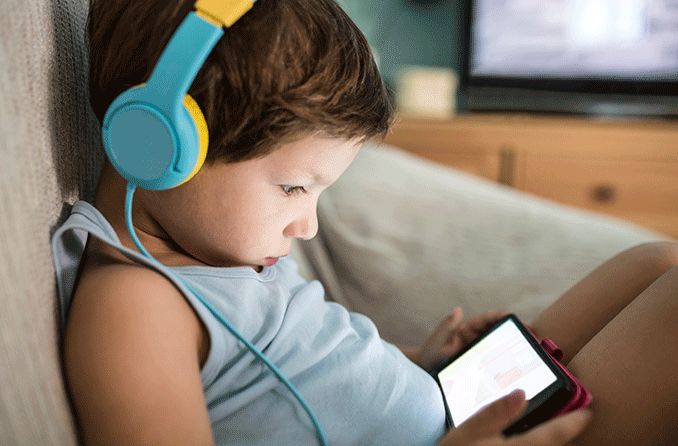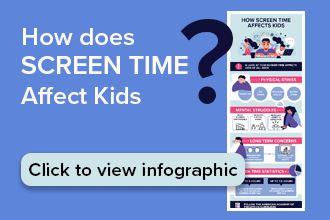How much screen time is okay for my child?

Although some digital programs are valuable (and enjoyable) for your child, spending too much time on a computer, tablet or in front of the television can be harmful for their development. Social skills, fine motor skills, mental health and vision development are among the areas of greatest concern.
Digital devices have been developed to be addictive, especially for children. This addictive quality has been studied and is difficult to control. Limiting screen time for your child can prevent such problems.
So just how much screen time is too much for kids? And how exactly can it affect their health and development?
How much screen time should my child be given?
The World Health Organization (WHO) suggests the following screen time for kids in a 24 hour period:
Infants (1 year old and younger): No screen time
1-2 years old: No screen time for 1-year-olds; 60 minutes or less for 2-year-olds
3-4 years old: 60 minutes or less
A child’s brain strongly develops in the first two years of life. During this time, it is more important for them to interact with the objects and people around them than it is to spend time viewing a screen.
Once they have reached 2 years of age and older, it’s okay to introduce screen time to your child on a limited basis. And it’s recommended that the programs they watch or play contribute to their growing minds.
FURTHER READING: Screen time recommendations by age
Problems with too much screen time
Experts warn that too much screen time can impact your child in the following ways:
Developmental skills can be delayed.
Fine motor skills such as writing or coloring may be impacted.
Children may struggle with eye contact and other social skills.
Creative and cognitive skills may be affected.
In addition to these issues, heavy use of screens can negatively affect your child’s vision.
Screen time and vision issues
Spending a lot of time indoors and looking at screens can be hard on your child’s eyes. Not only can it cause dry eyes, eye fatigue and digital eye strain — it can also impact vision development.
Children need to spend time outdoors for healthy vision development. In fact, studies show that spending more time in the daylight can help prevent conditions such as myopia (nearsightedness) from developing in your child. If your child already has myopia, exposure to natural, outdoor light may also help prevent it from getting worse.
Too much screen time can also cause dry or tired eyes. A slower rate of blinking when looking at computer, tablet or phone screens can irritate the eyes and cause discomfort. Prolonged screen time can make these symptoms even worse.
Note: The effects of too much screen time are not limited to children — adults are also encouraged to limit screen time when possible or wear computer glasses. Also consider a device filter to reduce glare when using a computer or other device.
SEE RELATED: How to help children avoid computer vision syndrome
Protect your children’s vision
Limiting screen time is just one important way to preserve your child’s vision and overall development. Be sure to engage your child in healthy activities unrelated to mobile apps or television programs. This is especially important to do if your child is very young.
Additionally, be sure to have your child’s vision checked on a yearly basis to identify and correct any vision problems they may have.
READ MORE ON SCREEN TIME:
Advantages of a 24-hour digital detox for kids
Is too much screen time bad for kids? How screens affect kids' eyes and what you can do about it
What are the effects of too much screen time?
Guidelines on physical activity, sedentary behavior and sleep for children under 5 years of age. World Health Organization. 2019.
Screen time guidelines for babies and toddlers. Nemours KidsHealth. January 2021.
New WHO guidance: Very limited daily screen time recommended for children under 5. American Optometric Association. May 2019.
Myopia prevention and outdoor light intensity in a school-based cluster randomized trial. Ophthalmology, the journal of the American Academy of Ophthalmology. 2018.
Page published on Wednesday, March 23, 2022
Medically reviewed on Monday, February 14, 2022








